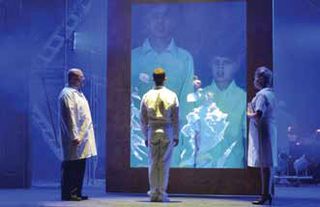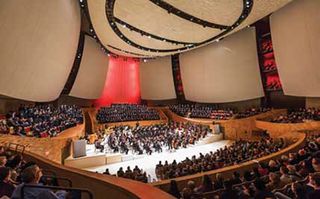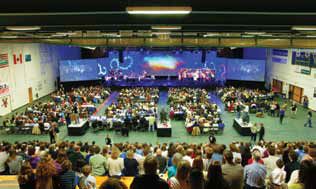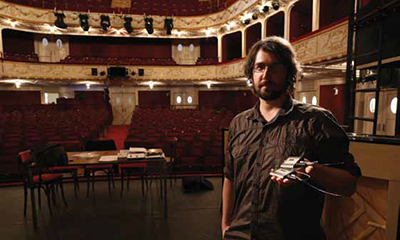Andreas Ivancsics, head of the sound department at Bühne Baden in Baden bei Wien, Austria, with some of the theater’s Lectrosonics SMDb body pack transmitters. What do the suits in the executive boardrooms and the amateur players in a church performance have in common with the entertainment pros? Plenty, even if they’ll never realize it.
As more corporate boardrooms and houses of worship (HOW) are designed with a theatrical bent, there’s much that the integration world can learn about microphone placement, handling, and setup from theater, cinema, and TV professionals.
“We are seeing many parallel trends in these industries,” said Gary Dixon, sales engineer of installed sound at Audio-Technica. “Corporate boardrooms are installing high-fidelity sound systems capable of multi-channel surround sound as well as using microphones for full-frequency response sound.”
The high-end boardrooms with telepresence systems are designed from the ground up, he noted, some with an ambient noise-floor that would rival some of the best Hollywood sound stages. “HOWs of all sizes are embracing the theater atmosphere. Gone are the days of fixed podiums and choir lofts with wired microphones; now the sanctuary is a multi-purpose area with no fixed spaces, similar to a theater stage.”

Due to significantly increased consumption of spectrum by consumer devices, wireless microphone products have had to become more spectrally efficient in order to get more channels on air in extremely crowded wireless environments such as in this stage production of Tommy featuring Lectrosonics mics. A backstage look at a modern worship facility reveals that the operation is almost indistinguishable from that of a Broadway show, acknowledged Kevin Waehner, channel manager of integrated systems for Sennheiser. “There’s already a ton of cross-pollination that has occurred over the years.”
Multi-zone antenna coverage has become a staple in broadcast facilities, he noted, and that is moving into HOW and corporate installations. “The basic idea is to have the speaker able to move between multiple areas of coverage, for example, a stage and a green room, two different studios, or two different meeting rooms, and be picked up in either system.”
Place, Set, Go
In terms of mic placement, gain before feedback is greatly enhanced by the close proximity of the mic capsule to the speakers’ or performers’ mouths, said Karl Winkler, director of business development for Lectrosonics. “Use of headset or earset mics is much preferred to using lavaliere mics for these kinds of events.”
As for wireless mic setup, frequency coordination gives the user a huge advantage over non-coordinated systems, he added. “With today’s software, some supplied by manufacturers and some third party packages, frequency coordination is quick and easy.”
Trickle Down
It’s no secret that specialized entertainment and performing arts applications have influenced wireless mic product development for the commercial sound market.
Transmitters, for example, have become much smaller, largely driven by theatrical and film/video production. And belt pack units are not much larger than a cigarette lighter.
“Film production has driven the sound quality of wireless mics forward, and this is yet another benefit to staging, corporate, and HOW applications,” Winkler said. “No longer do wireless mics necessarily compromise the audio quality as they once did.”

Stanford University’s Bing Concert Hall, which has welcomed notable performers including cellist Yo-Yo Ma and performance artist Laurie Anderson, was recently outfitted with Shure UHF-R Wireless Microphone Systems. Understanding the acoustical needs of the venue, Sonitus Consulting selected UHF-R for its ability to deliver rock-solid, quality wireless audio. Pro Sound & Video Los Angeles was also an integral part of the gear’s installation. As the performance market has evolved, so have the products that serve it, explained Erik Vaveris, category director of wireless products for Shure. “For example, a theatrical production might have used just a handful of wireless microphones 25 or 30 years ago, but now it is very common to see almost every performer onstage using a wireless mic.”
Due to significantly increased consumption of spectrum by consumer devices, wireless microphone products have had to become more spectrally efficient in order to get more channels on air in extremely crowded wireless environments such as Broadway.
“Costumes, and the placement of mics on performers, have also affected the form factor of these products,” he added. “Today, manufacturers have to make smaller products that are concealable in tight, hidden places.”
Recharge Yourself
Another major product feature that has become more of a priority is a reliable rechargeable battery solution. Traditional, off-the-shelf rechargeable offerings are simply not up to the task when it comes to critical applications, Vaveris stated.
“Shure has spent years developing its current rechargeable battery technology. Utilizing rechargeable batteries saves the end-user money and can even pay for the product over a relatively short period of time, not to mention the green aspect of using rechargeable batteries.”
Increased spectral efficiency, improved form factor, and rechargeable battery technology have all made their way into many of the current product offerings in the commercial market.
“The combination of these factors has really allowed Shure to develop products that integrate well into the marketplace for theaters and live entertainment venues, corporate boardrooms, and houses of worship, all while proving high-quality audio,” Vaveris said.
One key to clear and transparent audio in theater and cinema is individual miking. “Theater sound professionals have pioneered the use of wireless miniature condenser microphones hidden in costumes and worn on the head,” Dixon said. “Today we see many church leaders, both contemporary and traditional, using these sub-miniature condenser elements discreetly worn behind the ear or hidden in ceremonial vestments.”

“Film production has driven the sound quality of wireless mics forward, and this is yet another benefit to staging, corporate, and HOW applications,” noted Karl Winkler of Lectrosonics. In corporate AV, using one microphone for two or more people with some heavy EQ and gating was the norm ten years ago. “As the quality of conferencing systems increases, the sound systems are being tasked to be more natural and human,” he added. “So, close-miking individuals at the boardroom table is ideal to achieving high-quality sound.”
Theater and cinema audio techs do a great job of miking a sound source while keeping the aesthetics of the scene, Dixon said. “This is carried over into the conference room and HOW technologies by consultants, who suggest that the microphones be placed out of sight. We have many great solutions for this requirement, ranging from suspended mics and tabletop goosenecks to recessed boundary mics.”
Karen Mitchell is a freelance writer living in Boulder, CO.
Sound Tips to the Trade
For integrators working on systems for theatrical-style presentations, particularly in HOWs, it’s not just the curtain, but the bar that is being raised.
More and more technology, including video screens and projection, LED lighting, theatrical set designs, and wireless microphones/ wireless communications systems are being integrated into this environment, increasing the challenge, said Lectrosonics’ Karl Winkler.
“First, it is always critical to have the actors and presenters heard by the audience. From there, the rest of the design can be considered. But if sound and intelligibility is merely an afterthought, mic problems will be much more difficult to solve.”
Location of the receiver antennas is very important from a number of perspectives, Winkler emphasized. ”Ideally, having the receiver antennas, one on each side of what would, in a theater, be the proscenium, helps ensure coverage of the transmitters no matter where the performers end up on the stage. Having them above head height and ten feet off the deck is appropriate, ensuring line of sight between transmitters and receiver antennas.”
Antenna cable run lengths need to be considered. Often, the receiver rack is positioned on one side of the stage, so one antenna run can be short while the other one will be much longer.
“It is important to compensate for any RF losses in long cables by placing an RF amp at the antenna end of the cable,” he said. “Much can be learned from the theater style placement of lav microphones as well. With contemporary costumes this is not as critical since today’s audiences are used to seeing technology everywhere.”
For period costumes, the sight of technology can ruin the suspension of disbelief. Hiding the transmitters is important, but at the same time, the materials used to cover the transmitter must be considered.
Any metallic fabrics can cause loss from the transmitters by absorbing RF energy,” Winkler cautioned. “Similarly, the transmitters should not be placed on bare skin or against undergarments or layers damp from sweat. Costumers often can sew in a pouch for the transmitter that will satisfy the aforementioned criteria.”
—K.M.











